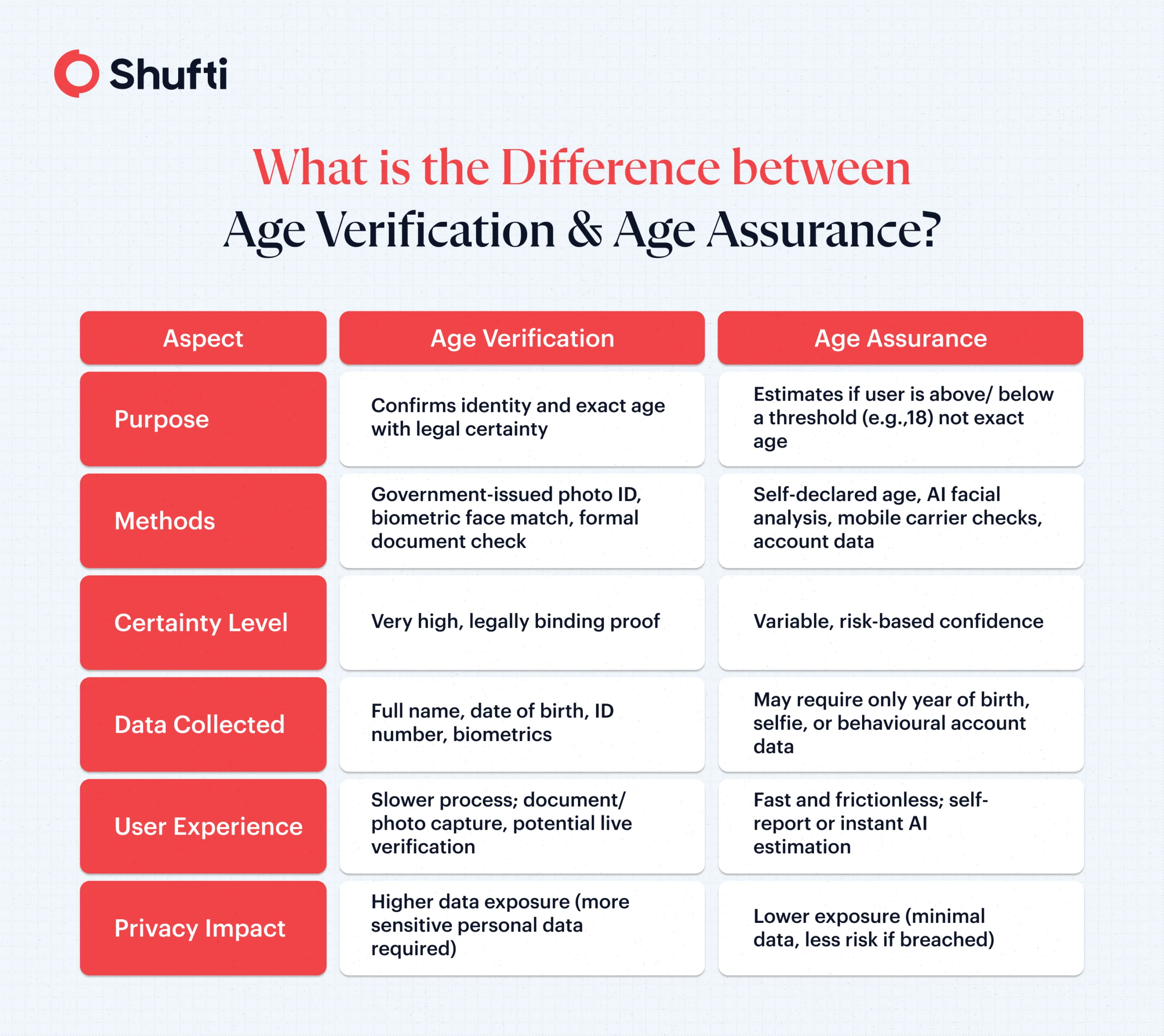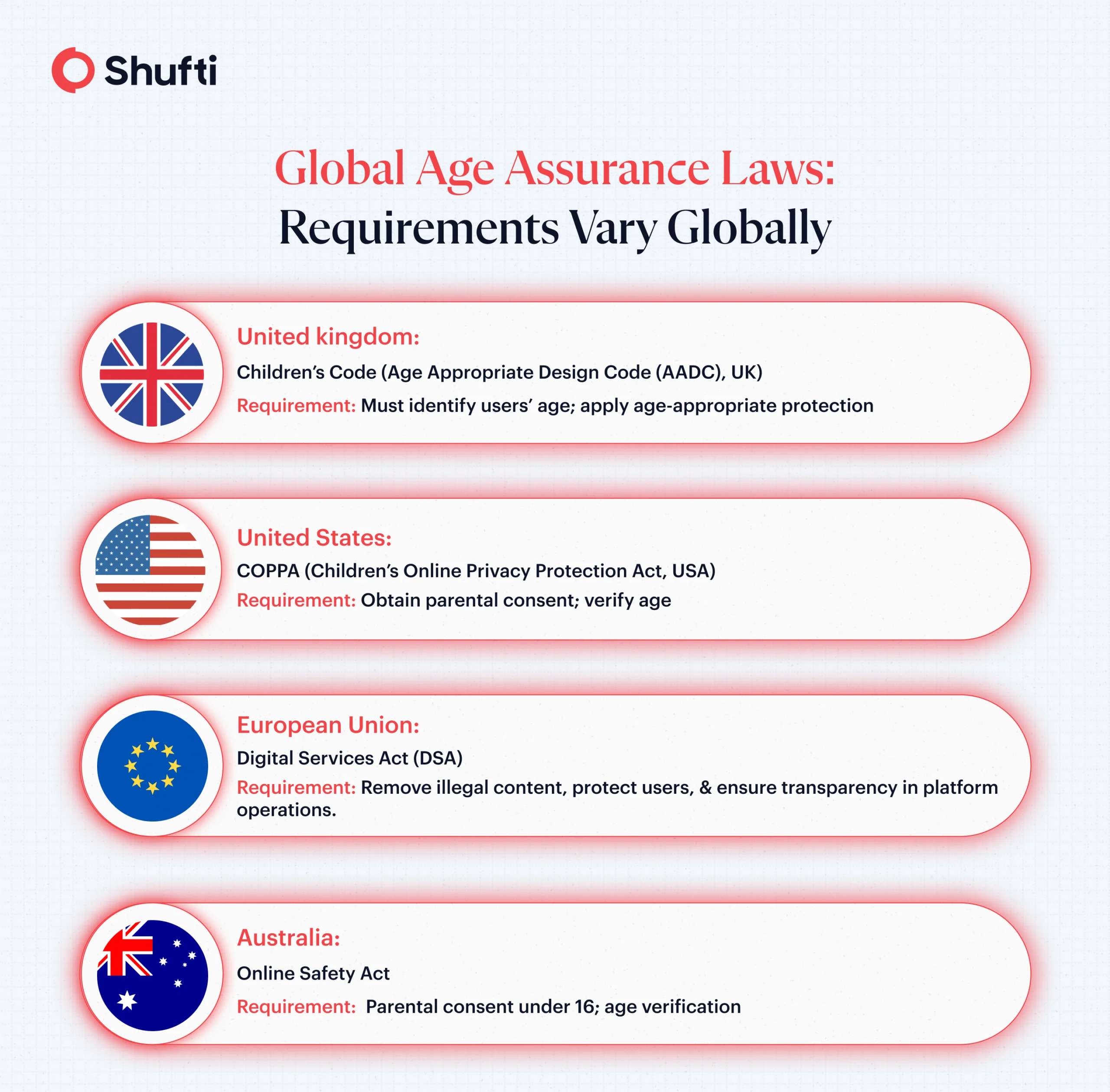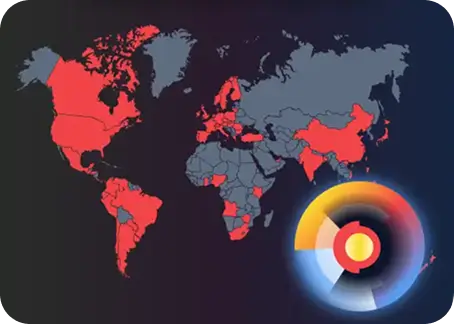Understanding Age Verification vs Age Assurance: What’s the Difference

- 01 Role of Age Assurance for a Secure Digital First Experience
- 02 What is the Difference between Age Assurance and Age Verification?
- 03 Global Regulations Shaping the Future of Online Age Checks
- 04 How Adaptibility in Age Assurance Builds Trust and Balances Privacy with Compliance
- 05 How Businesses Can Simplify Compliance Through Frictionless Age Verification?
- 06 How Shufti’s Age Verification Solution Helps Businesses Stay Fully Compliant
Traffic to adult sites in the UK immediately fell by nearly 47% after age-verification rules were enforced under the Online Safety Act. This decline was reported by the BBC on August 13, 2025, after enforcement on July 25, 2025.
Such a consequence of necessary age verification under the Online Safety Act is a classic case of a trade-off between compliance and user experience, the very challenge faced by businesses in the digital-first world. This friction due to the implementation of the Online Safety Act not only resulted in the drop-offs of users but also brought about the failure of the regulators, as many users resorted to using unregulated websites with no age verification or using VPNs for all site traffic to bypass it.
In the end, a system that was meant to make the internet safer ironically pushed users towards riskier and unregulated corners of the internet. The way forward lies in using smarter, simpler methods that protect users without getting in their way. And to get that balance right, it’s important to understand the difference between age assurance and age verification.
Role of Age Assurance for a Secure Digital First Experience
The digital world is borderless, which is, accountability-wise, both a strength and a weakness. Young people of today are at risk of exposure to the harmful content that may not be appropriate for their consumption. They get incessantly influenced, and sometimes even taken advantage of, by means of platforms that are not appropriate for children.
Starting from unsolicited calls and manipulative in-game prompts down to an overwhelming flood of advertising and sexually explicit content, the online environment can be an unsafe domain for children. According to a 2023 UK Ofcom study, 53% of children aged 12–17 reported encountering potentially harmful content online in the past 12 months.
This explains why verifying age has become a very serious concern to ensure that children are shielded from harmful content. However, compliance with such regulations is not smooth, as businesses often struggle to meet strict legal requirements while keeping user trust and ensuring a seamless onboarding process.
The main problem is to find a way to make the process of trust-building as non-intrusive as possible while still ensuring safety. And this is why choosing a solution that offers the right balance of privacy, convenience, and compliance is necessary.
What is the Difference between Age Assurance and Age Verification?

The UK Information Commissioner’s Office (ICO) provides specific guidance on age verification and age assurance, especially in relation to online services targeting or accessible to children. It does not endorse any single method but emphasizes that the level of age certainty in age assurance must be proportionate to the risk, while ensuring that user privacy is always protected.
What is Age Verification?
Age verification is a process that confirms a customer’s exact age with the highest level of certainty, typically using methods such as official identity documents or data.
What is Age Assurance?
On the other hand, age assurance is a broader concept and may include any method of verification that is focused on estimating age or determining whether a user falls within an age range (e.g, under 13 or 21).
Global Regulations Shaping the Future of Online Age Checks
Across regions, age assurance has always been a regulatory requirement and is now becoming a key part of responsible digital governance.

The UK Online Safety Act has been one of the laws that introduced a duty of care to digital services for the purpose of blocking minors’ access to harmful content.
In Europe, the EDPB Statement 1/2025 already foreshadowed the harmony of the age assurance criteria with the principles of the GDPR. The document clearly spells out the following expectations:
- Data minimization: gather the least amount of data necessary.
- Proportionality: the methods used should correspond to the level of risk.
- Auditability: the procedures are carried out in such a way that their results can be reproduced and that the whole process is open to inspection.
At the same time, in the US, the Children’s Online Privacy Protection Act (COPPA) has for a long time imposed tough requirements on collecting data of users below 13 years. Recent suggestions are broadening these restrictions to the already popular platforms among teenagers and require the following.
- Applicability: Applies to websites and online services directed to children below the age of 13, including those collecting personal data from children under 13 in the US.
- Parental Consent: Operators get verifiable parental consent before collecting or using information of children below 13.
- Data Minimization: Only collect information that is necessary for participation in the activity.
- Parental Rights: Parents can review, delete, or refuse further collection of their child’s personal information.
How Adaptibility in Age Assurance Builds Trust and Balances Privacy with Compliance
Age assurance is an umbrella term for age verification, providing a certain level of assurance sufficient to satisfy a given situation without asking for unnecessary personal information. For example, it might tell whether a user is likely under or over 18 without knowing exactly who they are in situations that don’t fall under strict identification laws.
This approach is helpful in multiple ways:
Trust building: Parents, regulators, and even users can feel more at peace that children are being safeguarded from adult or harmful content, showing that the platform takes safety seriously.
Privacy Protection: Such systems don’t ask users to share their complete identity documents or personal data. Therefore, they can prove they are old enough without revealing their private details. This can be done through facial age estimation, third-party confirmation, behavioral signals, or relying on device or account-based data.
Ensuring compliance: Global regulations require online platforms to protect minors. Age assurance helps businesses comply with these regulations while keeping the user experience smooth and respectful.
How Businesses Can Simplify Compliance Through Frictionless Age Verification?
Adaptability is the key to what lies ahead in online safety in implementing age verification regulations. When choosing age verification, businesses have to be careful. This is because they don’t only have to ensure accuracy in compliance but also a frictionless approach. Those services that install smart verification systems that take into account convenience will not only prevent non-compliance but also prevent the customer drop off.
The risk-based approach is the core of the best age verification systems, and it is very efficient. The system first goes through low-friction checks using behavioral biometrics or age estimation, and only escalates if a higher level of assurance is needed as per the business’s particular risk exposure.
This “waterfall” model prevents unnecessary drop-offs by allowing businesses to offer a frictionless experience, ensuring each user journey remains seamless, regardless of their risk level or region.
As regulations evolve and digital identities become central to online trust, one thing is clear:
True safety is not about adding barriers; it is about building smarter systems that balance privacy with protection.
By adopting privacy-centric age assurance, platforms can create a digital world where users feel safe, businesses stay compliant, and trust becomes the foundation of every interaction.
How Shufti’s Age Verification Solution Helps Businesses Stay Fully Compliant
Implementation of age assurance is not merely about ticking the compliance boxes. This is more about redefining digital responsibility. As regulatory demands intensify and users expect greater safety, businesses must strike a balance that protects minors without dropping off legitimate users.
Shufti empowers compliance and product teams to implement advanced age assurance systems that surpass traditional methods. Our privacy-first, intelligent age verification solution both safeguards minors and upholds the highest standards of data protection.
The solution employs a multi-layered approach, including database age checks, biometrics, AI-driven age estimation, document verification, and rapid age re-verification. To further address privacy concerns, we leverage advanced cryptographic technologies such as selective disclosures and zero-knowledge proofs. These enable users to confirm age thresholds with Yes or No without revealing sensitive information, ensuring both robust verification and privacy.
Shufti’s proportional, seamlessly integrated assurance measures prepare platforms for evolving digital safety regulations and expectations.
Shufti’s age verification helps platforms create safer, compliant, and age-appropriate digital spaces for all.
Contact us today to learn more or request a demo to see how it works.










